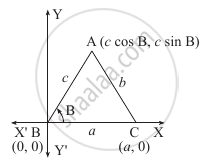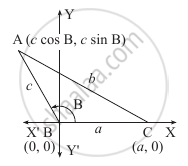Advertisements
Advertisements
प्रश्न
In any ΔABC, with usual notations, prove that b2 = c2 + a2 – 2ca cos B.
उत्तर


Let us take the angle B of ΔABC in standard position,
i.e. B as origin, X-axis along the line BC and the Y-axis perpendicular to the line BC.
In the two figures, ∠B is shown as acute in one and obtuse in the other.
∵ l(BC) = a
∴ C ≡ (a, 0)
Let A ≡ (x, y)
Since l (BA) = c, we have
cos B = `x/c` and sin B = `y/c`
∴ x = c cos B and y = c sin B
∴ A ≡ (c cos B, c sin B)
∴ By the distance formula
b2 = AC2 = (a – c cos B)2 + (0 – c sin B)2
= a2 – 2ca cos B + c2 cos2B + c2 sin2B
= c2(cos2B + sin2B) + a2 – 2ca cos B
∴ b2 = c2 + a2 – 2ca cos B.
APPEARS IN
संबंधित प्रश्न
In a Δ ABC, with usual notations prove that:` (a -bcos C) /(b -a cos C )= cos B/ cos A`
In ΔABC with usual notations, prove that 2a `{sin^2(C/2)+csin^2 (A/2)}` = (a + c - b)
In Δ ABC, if a = 13, b = 14 and c = 15, then sin (A/2)= _______.
(A) `1/5`
(B) `sqrt(1/5)`
(C) `4/5`
(D) `2/5`
The angles of the ΔABC are in A.P. and b:c=`sqrt3:sqrt2` then find`angleA,angleB,angleC`
If in ∆ABC with usual notations a = 18, b = 24, c = 30 then sin A/2 is equal to
(A) `1/sqrt5`
(B) `1/sqrt10`
(C) `1/sqrt15`
(D) `1/(2sqrt5)`
In , ΔABC prove that
`"sin"(("B" - "C")/2) = (("b" - "c")/"a") "cos"("A"/2)`
In , ΔABC with usual notations prove that
(a-b)2 cos2 `("C"/2) +("a"+"b")^2 "sin"^2("C"/2) = "c"^2`
Find the Cartesian coordinates of the point whose polar coordinates are :
`(4, pi/2)`
Find the Cartesian co-ordinates of the point whose polar co-ordinates are:
`(1/2, (7pi)/3)`
Find the polar co-ordinates of the point whose Cartesian co-ordinates are.
`(0, 1/2)`
Find the polar co-ordinates of the point whose Cartesian co-ordinates are.
`(1, - sqrt(3))`
Solve the triangle in which a = `(sqrt3 + 1)`, b = `(sqrt3 - 1)` and ∠C = 60°.
In any Δ ABC, prove the following:
a sin A - b sin B = c sin (A - B)
In any ΔABC, prove the following:
`("c" - "b cos A")/("b" - "c cos A") = ("cos B")/("cos C")`
In any Δ ABC, prove the following:
a2 sin (B - C) = (b2 - c2) sin A.
In Δ ABC, if ∠C = 90°, then prove that sin (A - B) = `("a"^2 - "b"^2)/("a"^2 + "b"^2)`
In ΔABC, if `"cos A"/"a" = "cos B"/"b"`, then show that it is an isosceles triangle.
Show that `2 sin^-1 (3/5) = tan^-1(24/7)`
Show that `(9pi)/8 - 9/4 sin^-1 (1/3) = 9/4 sin^-1 ((2sqrt2)/3)`.
If sin `(sin^-1 1/5 + cos^-1 x) = 1`, then find the value of x.
State whether the following equation has a solution or not?
cos 2θ = `1/3`
Solve: `tan^-1 ("1 - x"/"1 + x") = 1/2 (tan^-1 "x")`, for x > 0.
Solve: `tan^-1 ("1 - x"/"1 + x") = 1/2 (tan^-1 "x")`, for x > 0.
In ∆ABC, if cos A = `(sinB)/(2sinC)`, then ∆ABC is ______.
In ∆ABC, if ∠A = 30°, ∠B = 60°, then the ratio of sides is ______.
In ∆ABC, if b2 + c2 − a2 = bc, then ∠A = ______.
Find the Cartesian co-ordinates of point whose polar co-ordinates are `(4, pi/3)`
With usual notations, prove that `(cos "A")/"a" + (cos "B")/"b" + (cos "C")/"c" = ("a"^2 + "b"^2 + "c"^2)/(2"abc")`
In ΔABC, if a cos A = b cos B, then prove that ΔABC is either a right angled or an isosceles triangle.
In ∆ABC, if `(2cos "A")/"a" + (cos "B")/"b" + (2cos"C")/"c" = "a"/"bc" + "b"/"ca"`, then show that the triangle is a right angled
In ∆ABC, prove that `sin ((A - B)/2) = ((a - b)/c) cos C/2`
In ΔABC, prove that `("b"^2 - "c"^2)/"a" cos"A" + ("c"^2 - "a"^2)/"b" cos"B" + ("a"^2 - "b"^2)/"c" cos "C"` = 0
In ∆ABC, if ∠A = `pi/2`, then prove that sin(B − C) = `("b"^2 - "c"^2)/("b"^2 + "c"^2)`
In ΔABC, a(cos2B + cos2C) + cos A(c cos C + b cos B) = ?
In a ΔABC, cot `(("A - B")/2)* tan (("A + B")/2)` is equal to
In a triangle ABC with usual notations, if `(cos "A")/"a" = (cos "B")/"b" = (cos "C")/"c"`, then area of triangle ABC with a = `sqrt6` is ____________.
In a triangle ABC, If `(sin "A" - sin "C")/(cos "C" - cos "A")` = cot B, then A, B, C are in ________.
If one side of a triangle is double the other and the angles opposite to these sides differ by 60°, then the triangle is ______
The polar co-ordinates of P are `(2, pi/6)`. If Q is the image of P about the X-axis then the polar co-ordinates of Q are ______.
In ΔABC if sin2A + sin2B = sin2C and l(AB) = 10, then the maximum value of the area of ΔABC is ______
In ΔABC, if `cosA/a = cosB/b,` then triangle ABC is ______
The smallest angle of the ΔABC, when a = 7, b = `4sqrt(3)` and c = `sqrt(13)` is ______.
In `triangleABC,` if a = 3, b = 4, c = 5, then sin 2B = ______.
If in a `triangle"ABC",` a2cos2 A - b2 - c2 = 0, then ______.
In ΔABC, if `"a" cos^2 "C"/2 + "c" cos^2 "A"/2 = (3"b")/2`, then a, b, c are in ______.
In ΔABC, `cos"A"/"a" = cos"B"/"b" cos"C"/"c"`. If a = `1/sqrt(6)`, then the area of the triangle is ______.
In a ΔABC, if `sin"A"/sin"C" = (sin("A" - "B"))/(sin("B" - "C"))`, then a2, b2, c2 are in ______.
In a ΔABC, if a = `sqrt(2)` x and b = 2y and ∠C = 135°, then the area of triangle is ______.
If in a triangle ABC, AB = 5 units, AB = 5 units, ∠B = `cos^-1 (3/5)` and radius of circumcircle of ΔABC is 5 units, then the area (in sq.units) of ΔABC is ______.
The number of solutions of the equation sin 2x – 2 cosx + 4 sinx = 4 in the interval [0, 5π] is ______.
In a triangle ABC, in usual notation, (a + b + c)(b + c – a) = λbc will be true if ______.
If in a ΔABC `a cos^2(C/2) + c cos^2(A/2) = (3b)/2`, then the sides a, b and c ______.
In a triangle ABC, ∠C = 90°, then `(a^2 - b^2)/(a^2 + b^2)` is ______.
In ΔABC, `(a - b)^2 cos^2 C/2 + (a + b)^2 sin^2 C/2` is equal to ______.
In any ΔABC, prove that:
(b + c) cos A + (c + a) cos B + (a + b) cos C = a + b + c.
In ΔABC, a = 3, b = 1, cos(A – B) = `2/9`, find c.
